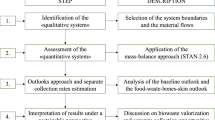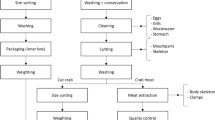Abstract
Considering the lack of an in-depth and comprehensive study on slaughter waste quantification and its management, despite the growing demand for meat this study aims to quantify the slaughter waste generated in Mumbra, Thane, India, from the meat retail stores. The study also endeavors to find the composition of slaughter waste in municipal solid waste by employing the questionnaire survey method. The literature reviewed the published studies on the life cycle analysis of food products for global warming potential values for meat and vegetable products along with the vegetarian and non-vegetarian dietary patterns. In this study, it was observed that 55.93% of the population were non-vegetarian consumers and the composition of slaughter waste was 7% of total municipal solid waste disposed of in disposal sites resulting in greenhouse gas emission of 0.11 Gg CO2 Eq./year. The study presents the implementation of a biomethanation plant as a mitigation measure, along with an evaluation of the theoretical biogas potential and electricity generation capacity derived from slaughter waste, considering it as a potential feedstock. The outcomes of this study also highlight the necessity for further focused research in this specific area, aiming to increase consumer knowledge regarding the environmental impacts of meat-based diets. The finding of this study will help researchers and assists policymakers in facilitating effective management and understanding the scale of the emissions resulting from meat products and slaughter waste and identifying suitable mitigation approaches, and actively contributing to reducing the environmental footprint.



Similar content being viewed by others
Data availability
The data used in the study are available from the corresponding author by reasonable request.
References
Abdeshahian, P., Lim, J. S., Ho, W. S., Hashim, H., & Lee, C. T. (2016). Potential of biogas production from farm animal waste in Malaysia. Renewable and Sustainable Energy Reviews, 60, 714–723. https://doi.org/10.1016/j.rser.2016.01.117
Afazeli, H., Jafari, A., Rafiee, S., & Nosrati, M. (2014). An investigation of biogas production potential from livestock and slaughterhouse wastes. Renewable and Sustainable Energy Reviews, 34, 380–386. https://doi.org/10.1016/j.rser.2014.03.016
Ali, M. M., Ndongo, M., Bilal, B., Yetilmezsoy, K., Youm, I., & Bahramian, M. (2020). Mapping of biogas production potential from livestock manures and slaughterhouse waste: A case study for African countries. Journal of Cleaner Production, 256, 120499. https://doi.org/10.1016/j.jclepro.2020.120499
Ayodele, T. R., Ogunjuyigbe, A. S. O., & Alao, M. A. (2018). Economic and environmental assessment of electricity generation using biogas from organic fraction of municipal solid waste for the city of Ibadan, Nigeria. Journal of Cleaner Production, 203, 718–735. https://doi.org/10.1016/j.jclepro.2018.08.282
Bhandare, S. G., Sherikar, A. T., Paturkar, A. M., Waskar, V. S., & Zende, R. J. (2007). A comparison of microbial contamination on sheep/goat carcasses in a modern Indian abattoir and traditional meat shops. Food Control, 18(7), 854–858. https://doi.org/10.1016/j.foodcont.2006.04.012
Calderón, L. A., Iglesias, L., Laca, A., Herrero, M., & Díaz, M. (2010). The utility of Life Cycle Assessment in the ready meal food industry. Resources Conservation and Recycling, 54(12), 1196–1207. https://doi.org/10.1016/j.resconrec.2010.03.015
Clune, S., Crossin, E., & Verghese, K. (2017). Systematic review of greenhouse gas emissions for different fresh food categories. Journal of Cleaner Production, 140, 766–783. https://doi.org/10.1016/j.jclepro.2016.04.082
CPCB, C. P. C. B. M. O. E. & F. (2004). Parivesh solid waste management in slaughter house. http://cpcbenvis.nic.in/cpcb_newsletter/Solid%20Waste%20Management%20in%20Slaughter%20House%20Parivesh%20Newsletter%20cpcb%20envis.PDF
CPHEEO. (2016). Municipal solid waste management manual part II : The manual. Ministry of Housing and Urban Affairs,Government of India. https://cpheeo.gov.in//cms/manual-on-municipal-solid-waste-management-2016.php
Čuček, L., Klemeš, J. J., & Kravanja, Z. (2015). Chapter 5—Overview of environmental footprints. In J. J. Klemeš (Ed.), Assessing and measuring environmental impact and sustainability (pp. 131–193). Butterworth-Heinemann. https://doi.org/10.1016/B978-0-12-799968-5.00005-1
de Vries, M., & de Boer, I. J. M. (2010). Comparing environmental impacts for livestock products: A review of life cycle assessments. Livestock Science, 128(1), 1–11. https://doi.org/10.1016/j.livsci.2009.11.007
Farjana, S. H., Mahmud, M. A. P., & Huda, N. (2021). Chapter 1—Introduction to life cycle assessment. In S. H. Farjana, M. A. P. Mahmud, & N. Huda (Eds.), Life Cycle Assessment for Sustainable Mining (pp. 1–13). Elsevier. https://doi.org/10.1016/B978-0-323-85451-1.00001-9
Fiala, N. (2008). Meeting the demand: An estimation of potential future greenhouse gas emissions from meat production. Ecological Economics, 67(3), 412–419. https://doi.org/10.1016/j.ecolecon.2007.12.021
Green, R. F., Joy, E. J. M., Harris, F., Agrawal, S., Aleksandrowicz, L., Hillier, J., Macdiarmid, J. I., Milner, J., Vetter, S. H., Smith, P., Haines, A., & Dangour, A. D. (2018). Greenhouse gas emissions and water footprints of typical dietary patterns in India. Science of the Total Environment, 643, 1411–1418. https://doi.org/10.1016/j.scitotenv.2018.06.258
Heller, M. C., Keoleian, G. A., & Willett, W. C. (2013). Toward a life cycle-based, diet-level framework for food environmental impact and nutritional quality assessment: A critical review. Environmental Science and Technology, 47(22), 12632–12647. https://doi.org/10.1021/es4025113
IIPS, I. I. for P. S., & ICF. (2021). National Family Health Survey (NFHS-5), 2019–21 India: Volume I. http://rchiips.org/nfhs/
IPCC. (1996). Revised 1996 IPCC guidelines for national greenhouse gas inventories: Reference manual (volume 3). Intergovernmental panel on climate change. https://www.ipcc-nggip.iges.or.jp/public/gl/invs6e.html
IPCC. (2006). 2006 IPCC Guidelines for national greenhouse gas inventories volume 5 waste. IGES, Japan. https://www.ipcc-nggip.iges.or.jp/public/2006gl/vol5.html
IPCC. (2014). AR5 synthesis report: Climate change 2014-IPCC. https://www.ipcc.ch/report/ar5/syr/
Jain, R., & Sinha, R. (2014). Mumbra: A status report. Tata Institute of Social Sciences, Mumbai. https://mdd.maharashtra.gov.in/Site/Upload/Pdf/Mumbra.pdf
Jayathilakan, K., Sultana, K., Radhakrishna, K., & Bawa, A. S. (2012). Utilization of byproducts and waste materials from meat, poultry and fish processing industries: A review. Journal of Food Science and Technology, 49(3), 278–293. https://doi.org/10.1007/s13197-011-0290-7
Jha, A. K., Sharma, C., Singh, N., Ramesh, R., Purvaja, R., & Gupta, P. K. (2008). Greenhouse gas emissions from municipal solid waste management in Indian mega-cities: A case study of Chennai landfill sites. Chemosphere, 71(4), 750–758. https://doi.org/10.1016/j.chemosphere.2007.10.024
Kalhor, T., Rajabipour, A., Akram, A., & Sharifi, M. (2016). Environmental impact assessment of chicken meat production using life cycle assessment. Information Processing in Agriculture, 3(4), 262–271. https://doi.org/10.1016/j.inpa.2016.10.002
Kristanto, G. A., & Koven, W. (2019). Estimating greenhouse gas emissions from municipal solid waste management in Depok, Indonesia. City and Environment Interactions, 4, 100027. https://doi.org/10.1016/j.cacint.2020.100027
Kumar, N., & Kapoor, S. (2014). Study of consumers’ behavior for non-vegetarian products in emerging market of India. Journal of Agribusiness in Developing and Emerging Economies, 4(1), 59–77. https://doi.org/10.1108/JADEE-05-2013-0016
Macdiarmid, J. I., Kyle, J., Horgan, G. W., Loe, J., Fyfe, C., Johnstone, A., & McNeill, G. (2012). Sustainable diets for the future: Can we contribute to reducing greenhouse gas emissions by eating a healthy diet? The American Journal of Clinical Nutrition, 96(3), 632–639. https://doi.org/10.3945/ajcn.112.038729
Mozhiarasi, V., & Natarajan, T. S. (2022). Slaughterhouse and poultry wastes: Management practices, feedstocks for renewable energy production, and recovery of value added products. Biomass Conversion and Biorefinery. https://doi.org/10.1007/s13399-022-02352-0
MPCB, M. P. C. B. (2014). Thumb Rules for slaughter house waste management and design of pollution control systems/measures. JD (WPC);MPCB. https://www.mpcb.gov.in/node/735
Onurbaş Avcioğlu, A., & Türker, U. (2012). Status and potential of biogas energy from animal wastes in Turkey. Renewable and Sustainable Energy Reviews, 16(3), 1557–1561. https://doi.org/10.1016/j.rser.2011.11.006
Panneerselvam, M., Rangaraj, A., & Monisha, K. M. (2022). Experimental study on solid waste management in slaughter house. Materials Today Proceedings, 68, 1324–1329. https://doi.org/10.1016/j.matpr.2022.06.358
Pathak, H., Jain, N., Bhatia, A., Patel, J., & Aggarwal, P. K. (2010). Carbon footprints of Indian food items. Agriculture Ecosystems and Environment, 139(1), 66–73. https://doi.org/10.1016/j.agee.2010.07.002
Patra, A. K. (2017). Accounting methane and nitrous oxide emissions, and carbon footprints of livestock food products in different states of India. Journal of Cleaner Production, 162, 678–686. https://doi.org/10.1016/j.jclepro.2017.06.096
Scholz, K., Eriksson, M., & Strid, I. (2015). Carbon footprint of supermarket food waste. Resources Conservation and Recycling, 94, 56–65. https://doi.org/10.1016/j.resconrec.2014.11.016
Siddiki, S. K. Y. A., Uddin, M. N., Mofijur, M., Fattah, I. M. R., Ong, H. C., Lam, S. S., Kumar, P. S., & Ahmed, S. F. (2021). Theoretical calculation of biogas production and greenhouse gas emission reduction potential of livestock, poultry and slaughterhouse waste in Bangladesh. Journal of Environmental Chemical Engineering, 9(3), 105204. https://doi.org/10.1016/j.jece.2021.105204
Singh, C. K., Kumar, A., & Roy, S. S. (2018). Quantitative analysis of the methane gas emissions from municipal solid waste in India. Scientific Reports, 8(1), Article 1. https://doi.org/10.1038/s41598-018-21326-9
State Election commissioner, T. (2022). TMC/HQ-1/ELECTION-34/COMMISSIONER-191–2022. Thane Municipal Corporation. https://thanecity.gov.in/tmc/cache/1/01-Feb-22/EIP/EIP_PUBLIC_NOTICES/HOME_PAGE/1643693805817/Schedule%202_English.pdf
SWM Rules 2016, Solid waste management rules, 2016, https://cpcb.nic.in/rules-2/
van Herpen, E., van Geffen, L., Nijenhuis-de Vries, M., Holthuysen, N., van der Lans, I., & Quested, T. (2019). A validated survey to measure household food waste. MethodsX, 6, 2767–2775. https://doi.org/10.1016/j.mex.2019.10.029
Vetter, S. H., Sapkota, T. B., Hillier, J., Stirling, C. M., Macdiarmid, J. I., Aleksandrowicz, L., Green, R., Joy, E. J. M., Dangour, A. D., & Smith, P. (2017). Greenhouse gas emissions from agricultural food production to supply Indian diets: Implications for climate change mitigation. Agriculture Ecosystems and Environment, 237, 234–241. https://doi.org/10.1016/j.agee.2016.12.024
Author information
Authors and Affiliations
Contributions
Prashant P. Bhave: Conceptualization, methodology, validation, and writing—review and editing, as well as provided supervision. Areej L. Palekar: Methodology, investigation, data collection, and writing—original draft. All authors agree with the final version of the article and the author list. All authors read and approved the final manuscript.
Corresponding author
Ethics declarations
Consent for publication
All authors agreed to publish this article.
Competing interest
The authors declare no competing interests.
Additional information
Publisher's Note
Springer Nature remains neutral with regard to jurisdictional claims in published maps and institutional affiliations.
Supplementary Information
Below is the link to the electronic supplementary material.
Rights and permissions
Springer Nature or its licensor (e.g. a society or other partner) holds exclusive rights to this article under a publishing agreement with the author(s) or other rightsholder(s); author self-archiving of the accepted manuscript version of this article is solely governed by the terms of such publishing agreement and applicable law.
About this article
Cite this article
Bhave, P.P., Palekar, A.L. Quantification and environmental impact of slaughter waste during its life cycle. Environ Monit Assess 196, 225 (2024). https://doi.org/10.1007/s10661-024-12386-8
Received:
Accepted:
Published:
DOI: https://doi.org/10.1007/s10661-024-12386-8




